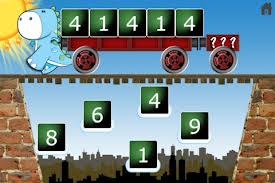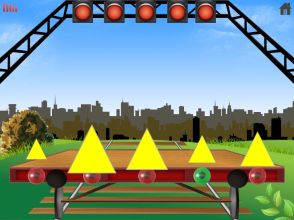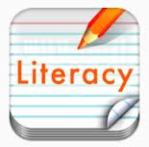 Basic concepts of pattern, order, colour, shape, size, counting and number are essential for the development of literacy and numeracy. These concepts receive a lot of attention in the early curriculum, particularly in Prep and Year 1, but they are also skills we should be practising with even younger children, such as those in Kindergarten. Caboose is an app with two activities to help develop and consolidate these concepts. The activities are fun and easy to play, and can be customised to suit individual needs.
Basic concepts of pattern, order, colour, shape, size, counting and number are essential for the development of literacy and numeracy. These concepts receive a lot of attention in the early curriculum, particularly in Prep and Year 1, but they are also skills we should be practising with even younger children, such as those in Kindergarten. Caboose is an app with two activities to help develop and consolidate these concepts. The activities are fun and easy to play, and can be customised to suit individual needs.
Patterns
A little dinosaur (or dragon – there is some debate in my household) tows a train across a bridge. Once on the bridge, the train stops and a pattern is highlighted. As each item in the pattern is highlighted, the name of the shape, colour or number is played. Letters can be sounded phonetically or named.

Drag the correct number to the caboose to complete the pattern
Children complete the pattern on the train by dragging or tapping (depending on settings) the next item in the pattern to the caboose. If successful, the train is dragged one step closer to the other side of the bridge. An incorrect answer will see the train go backwards, however it will never go back further than a total of 5 steps. Children don’t get a second attempt at the same pattern, but they do get to see the correct answer.
- Patterns include: ABAB, ABCABC, AABAAB, and more. Use the App settings to select particular patterns or practice them all by default.
- Pattern elements include: shapes, colours, numbers and letters (upper and lower case).
- Use the App settings to select either Tap or Drag and Drop as the way to complete the pattern.
- Letters can be named or sounded phonetically. Use the App settings to select your preference.
Sorting
Arrange five items in ascending or descending order.
Items include: Numbers 0-9, Uppercase or lowercase alphabet and size. As with the Patterns activity, you can select which items you wish the child to sort. Hints (in the form of green lights under each item) indicate when positions are correct. If you want to increase the challenge, you can turn off the hints using the app settings.

Rearrange the triangles to sort them from smallest to biggest. One is already in the right spot.
Instructions are only given once, which may be problematic for children who need instructions repeated, although a series of bars at the top of the screen can help cue to ascending or descending order, and the optional green light hints are helpful.
Wish list
It would be handy to have an option to repeat instructions. This would be useful for children with auditory processing problems, and handy in noisy environments such as classrooms (or my house on any given afternoon!)
Verdict
Caboose fits in well with our Prep and Year 1 curriculum and will also be useful for preschool and for older children with special needs. When I first downloaded the App, it only had the patterns activity, so I’m impressed that it has improved with added features in the time since I originally bought it. I like the way I can customise it to focus on a single element, such as numbers or alphabet (particularly in the sorting activity where children can practise ordering them in ascending or descending order.) At $1.99, it is good value and will suit children from Kindergarten to Yr 1.
Publisher: @Reks
Price: $1.99
Universal

Related Links
Literacy and Numeracy Fact Sheet – education.qld.gov.au/literacyandnumeracy/pdf/factsheet-l-n.pdf
Early Literacy and Numeracy: Building Good Practice – www.fdcqld.org/files/file/Buildinggoodpractice-earlychildhoodliteracyandnumberacy.pdf
Tags: early childhood, Education, Educational Apps, iPad
 You may have read my reviews of School Writing, School Fonts, and Ghost Type, three apps which I consider must-haves for teachers and parents alike. Today I’m reviewing a fourth app from Demografix, Literacy, that promises to be just as useful. There are two main sections to the app: Lessons – Words and Sentences, and Whiteboard activities.
You may have read my reviews of School Writing, School Fonts, and Ghost Type, three apps which I consider must-haves for teachers and parents alike. Today I’m reviewing a fourth app from Demografix, Literacy, that promises to be just as useful. There are two main sections to the app: Lessons – Words and Sentences, and Whiteboard activities.
 Baby Learns Simple Objects is the latest app from Bebebe, who also published
Baby Learns Simple Objects is the latest app from Bebebe, who also published 
 A few months ago I reviewed
A few months ago I reviewed 
 Baby Learns Colors is designed to do as the name suggests, but with more features than you might expect. These special features make it stand out from other similar apps and make it a useful, fun and motivating for kids in preschool, and for some older children too. Read on to find out more.
Baby Learns Colors is designed to do as the name suggests, but with more features than you might expect. These special features make it stand out from other similar apps and make it a useful, fun and motivating for kids in preschool, and for some older children too. Read on to find out more. Basic concepts of pattern, order, colour, shape, size, counting and number are essential for the development of literacy and numeracy. These concepts receive a lot of attention in the early curriculum, particularly in Prep and Year 1, but they are also skills we should be practising with even younger children, such as those in Kindergarten. Caboose is an app with two activities to help develop and consolidate these concepts. The activities are fun and easy to play, and can be customised to suit individual needs.
Basic concepts of pattern, order, colour, shape, size, counting and number are essential for the development of literacy and numeracy. These concepts receive a lot of attention in the early curriculum, particularly in Prep and Year 1, but they are also skills we should be practising with even younger children, such as those in Kindergarten. Caboose is an app with two activities to help develop and consolidate these concepts. The activities are fun and easy to play, and can be customised to suit individual needs.
